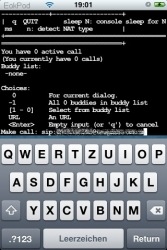 Will there soon be a native SIP client on the iPhone and iPod Touch? Dameon Welch-Abernathy writes on his VoIP weblog that some developers have gotten a basic SIP stack working on the iPhone and iPod Touch. The limited details available are over on The Unofficial Apple Weblog:
Will there soon be a native SIP client on the iPhone and iPod Touch? Dameon Welch-Abernathy writes on his VoIP weblog that some developers have gotten a basic SIP stack working on the iPhone and iPod Touch. The limited details available are over on The Unofficial Apple Weblog:
iPhone hacker eok writes to let me know that he and Samuel have gotten SIP registration and signalization working. They took a few mobile terminal shots, but the real work is being done via ssh. Samuel is working on connecting the audio in/out to the pjSIP. If you have iPhone or iPod touch coding skills and want to get involved in the project, connect to #touchmods on irc.undernet.org. It looks like most of the work will be done on European time.
As you can see in the screenshots, this is still very early in the development. Still, it’s great to see this kind of development taking place.
Technorati Tags:
sip, voip, apple, iphone, ipod touch
I can’t wait until this is fully finished. Keep up the great work developers 🙂
i would like to know when the SIP client or SIP phone will be avaliable. I need it for a project. Kindly specifiy the dates if possible.
Thankyou.